

Come sarebbe un mondo vegano? Uno studio dell’Università di Oxford. Rapid declines in coronary heart disease mortality in Eastern Europe are associated with increased consumption of oils rich in alpha-linolenic acid. E' allerta per lo zucchero nella dieta: bisogna ridurre la quantità Start - LAND MATRIX. 14 Steps To Cut Processed Foods. We took our own pledge for 100 days in part to convince others that they could follow our same “real food” rules for only 10 days.
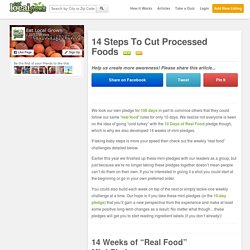
We realize not everyone is keen on the idea of going “cold turkey” with the 10 Days of Real Food pledge though, which is why we also developed 14 weeks of mini-pledges. If taking baby steps is more your speed then check out the weekly “real food” challenges detailed below. Earlier this year we finished up these mini-pledges with our readers as a group, but just because we’re no longer taking these pledges together doesn’t mean people can’t do them on their own. If you’re interested in giving it a shot you could start at the beginning or go in your own preferred order.
You could also build each week on top of the next or simply tackle one weekly challenge at a time. Week 1: Two fruits and/or vegetables per meal – Eat a minimum of two different fruits or vegetables (preferably organic) with every breakfast, lunch, and dinner meal. The Dark Side of Urban Farming. Growing food at home is good for your health and the planet, but your vegetables could be sucking up toxins as well as sunshine.

So, Why Should You Care? All around the world, more people are getting their hands dirty and planting crops to harvest at home. More than a third of all households in America are growing food at home or in community gardens—a 17 percent jump in five years, according to the National Gardening Association. About 15 percent of the world’s food is produced in urban areas, according to the United States Department of Agriculture. All of this urban farming raises questions about the safety of crops grown in cities, where soil may be contaminated with lead, arsenic, hydrocarbons, and other toxins. A recent study considered how different gardening practices could reduce a plant’s uptake of potential soil toxins. They found that in the majority of examples, eating vegetables grown in the contaminated soils studied was safe.
Takepart. At first glance, Hawaii would appear to have a dearth of body fat—it seems to be an archipelago populated by nothing more than surfing, fish-eating, healthy people.
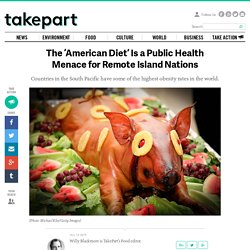
While that’s true for a certain demographic, the public health picture for some residents there and across the Pacific Islands is dire when it comes to obesity. Eight Pacific Island nations are among the 10 most obese in the world, according to the World Health Organization. When you count American Samoa, a U.S. territory that WHO pegs at a 94 percent obesity rate, the problem looks that much more daunting and close to home. Hawaii, which is still culturally, ethnically, and geographically in the Pacific Islands neighborhood, has the lowest obesity rate of the 50 states—just 19 percent, well below the 2014 national average of 27.7 percent, according to Gallup. So, Why Should You Care? Gli italiani e il cibo, presentato lo studio del Censis aExpo. È stato presentato il 4 luglio in Expo “Gli italiani e il cibo: rapporto su un’eccellenza da condividere”, ricerca del Censis realizzata per il Padiglione Italia che affronta il tema “Nutrire il pianeta” in relazione alla situazione sociale nel nostro Paese.
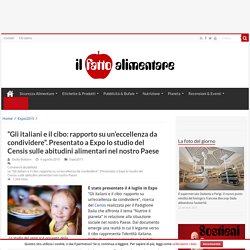
Dal documento emerge una realtà in cui il legame verso il cibo rappresenta l’identità italiana. L’atto di cucinare e mangiare è legato alla convivialità e al piacere di stare insieme; ma, allo stesso tempo, i numeri rivelano che le difficoltà economiche hanno acuito le disuguaglianze alimentari. Sono 29,4 milioni gli italiani che si definiscono appassionati, ovvero persone a cui piace informarsi e parlare di cibo; 12,6 milioni si ritengono intenditori, capaci di discutere con buone nozioni su preparazioni, ricette e tradizioni; 4,1 milioni si considerano veri esperti. Acqua minerale: il decalogo per smentire le false pubblicità. L’acqua minerale è un argomento molto dibattuto nel nostro Paese perché si tratta di un prodotto da sempre posizionato in cima alla classifica dei consumi alimentari e perché siamo i più affezionati bevitori in Europa.

Per fortuna la frequenza di acquisto è diminuita negli ultimi anni, passando da quasi 190 litri annui pro capite nel 2008 a meno di 180 nel 2013. I messaggi pubblicitari per incentivare le persone ad acquistare l’acqua in bottiglia sono sempre stati insistenti e spesso ingannevoli: l’ultimo caso è la censura di una pubblicità della Fonte Essenziale, marchio di proprietà Ferrarelle, che prometteva di purificare il fegato. Uno degli ultimi documenti realizzato dall’Inran ora Crea è un decalogo sull’acqua minerale, che risale a qualche anno fa ma è ancora validissimo. Purtroppo è un documento poco ripreso dai media . Ecco il decalogo. How Did Palm Oil Become Such A Problem — And What Can We Do About It? Production of this ubiquitous ingredient is devastating for the environment.
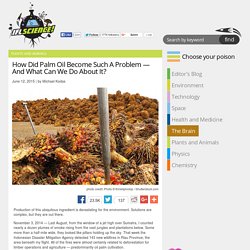
Solutions are complex, but they are out there. November 3, 2014 — Last August, from the window of a jet high over Sumatra, I counted nearly a dozen plumes of smoke rising from the vast jungles and plantations below. Some more than a half-mile wide, they looked like pillars holding up the sky. That week the Indonesian Disaster Mitigation Agency detected 143 new wildfires in Riau Province, the area beneath my flight. All of the fires were almost certainly related to deforestation for timber operations and agriculture — predominantly oil palm cultivation. Palm oil — which appears in a dizzying amount of food and cosmetic products, and is a feedstock for biofuel — poses many environmental problems.
Solutions to the environmental problems posed by palm production are complicated, partly because palm oil’s ubiquity, but also because alternatives lack many of the benefits of the versatile oil. Burning Below. News Article: Food waste harms climate, water, land and biodiversity – new FAO report. In France, food waste waits to be converted into methane and biogas. 11 September 2013, Rome - The waste of a staggering 1.3 billion tonnes of food per year is not only causing major economic losses but also wreaking significant harm on the natural resources that humanity relies upon to feed itself, says a new FAO report.

Food Wastage Footprint: Impacts on Natural Resources is the first study to analyze the impacts of global food wastage from an environmental perspective, looking specifically at its consequences for the climate, water and land use, and biodiversity. Among its key findings: Each year, food that is produced but not eaten guzzles up a volume of water equivalent to the annual flow of Russia's Volga River and is responsible for adding 3.3 billion tonnes of greenhouse gases to the planet's atmosphere. "We simply cannot allow one-third of all the food we produce to go to waste or be lost because of inappropriate practices, when 870 million people go hungry every day," he added. Nutella: il segreto degli ingredienti svelato da un sito tedesco. L’organizzazione Verbraucherzentrale Hamburg che si occupa di consumi e informazione ha pubblicato sulla propria pagina Facebook una rappresentazione approssimativa del contenuto di un vasetto di Nutella basandosi sulle informazioni nutrizionali e sull’elenco degli ingredienti riportati in etichetta.
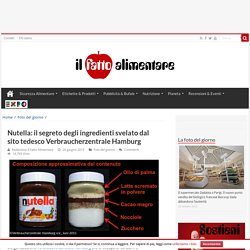
Il risultato si può vedere nella parte destra dell’immagine. Balza subito all’occhio la quantità elevata di zucchero (in basso) e di olio di palma (in alto). In commercio esistono molte altre creme di nocciola che utilizzano al posto dell’olio di palma il pregiato burro di cacao o altri grassi vegetali e che hanno spesso un cospicuo contenuto di nocciole. Certo i prezzi potranno essere più alti, ma come conseguenza ai costi delle materie prime impiegate. L’elenco delle 49 creme senza olio di palma lo trovate cliccando qui. Foto: ©Verbraucherzentrale Hamburg. Got Milk? Throw it away. I formaggi con e senza caglio animale. Il formaggio, secondo la legge e secondo quanto riportato dal volume "Il cucchiaio verde" (Giunti, 2007), è un prodotto che si deriva da latte intero, parzialmente o totalmente scremato, oppure dalla crema di latte, in seguito a coagulazione acida o presamica.
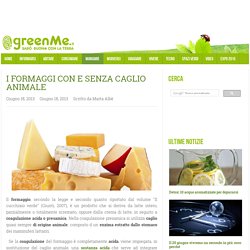
UN warns world must produce 60% more food by 2050 to avoid mass unrest. Il land grabbing arriva in Europa. Start - LAND MATRIX.